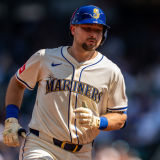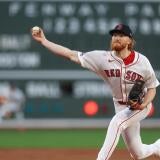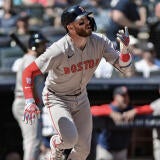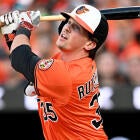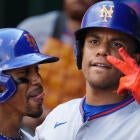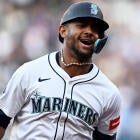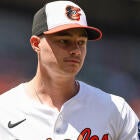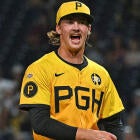MLB trends: Mookie Betts' slump, Andrew Vaughn's breakout and how the Rangers blew an easy deadline upgrade
The dog days of summer have arrived
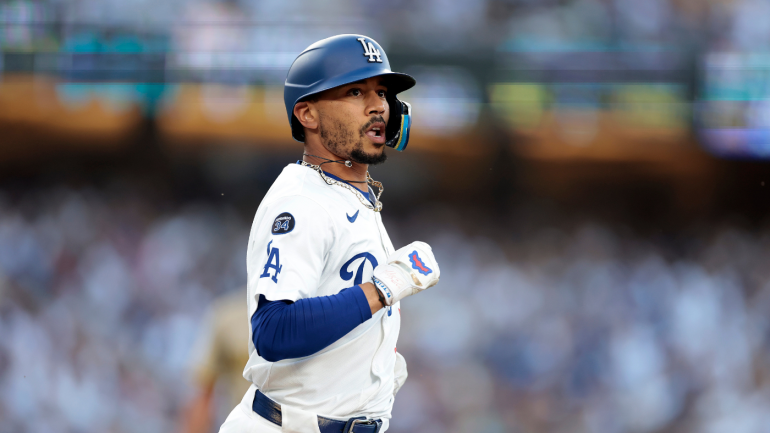
The trade deadline has come and gone and the dog days of summer have arrived. Fewer than eight weeks remain in the 2025 MLB regular season. Pretty soon the postseason and awards races will really heat up, and very meaningful games will be played every night. Here are three trends worth keeping an eye on as baseball heads into the stretch drive.
Mookie's down year
It is now August, and Mookie Betts' slow start has morphed into a down season and the worst year of his Hall of Fame career. Betts took a .231/.302/.355 batting line into Tuesday's game. His 85 OPS+ indicates he has been 15% worse than the league-average hitter, and that is well below his career 135 OPS+. Mookie's previous career low was a 108 OPS+ way back in 2017.
"I've done everything possible," Betts said this past weekend when asked what he's trying to do to get his season on the rails (via USA Today). "It's just kind of the same result. I'm out of answers. I've done everything I can do. It's up to God at this point."
Despite the season-long slump, Dodgers manager Dave Roberts has declined to move Betts down in the order, opting to instead leave him in the 1-2 spots alongside Shohei Ohtani, Will Smith, and Freddie Freeman. Roberts did give Betts a mental break day on July 19. That was the second day back after the All-Star break, when he theoretically was plenty rested physically.
The under-the-hood numbers are worrisome. Betts is making the worst contact of his career this season and his underwhelming results are deserved, not a blip. Here are the numbers going into Tuesday night's game. You can see the multi-year decline:
| 2025 | 2024 | 2023 | |
|---|---|---|---|
Average exit velocity | 88.3 mph | 89.9 mph | 92.4 mph |
Max exit velocity | 107.2 mph | 109.4 mph | 110.1 mph |
Barrel rate (what's this?) | 5.0% | 6.0% | 12.4% |
Sweet-spot rate (what's this?) | 33.8% | 39.3% | 42.5% |
Expected batting average | .250 | .282 | .294 |
Expected slugging percentage | .394 | .447 | .563 |
Fast swing rate (what's this?) | 6.5% | 9.6% | 20.7% |
Plain and simple, Betts is making the worst contact of his career. He's not hitting the ball has hard as he had previously -- despite being a smaller player, Mookie's hard-hit ability has long been well-above-average -- and he's also hitting it at poor angles, meaning fewer line drives and more power pop-ups and routine fly balls, which are close to automatic outs.
Furthermore, Betts is not hitting fastballs well. Two years ago, he hit .324 with a .596 slugging percentage against heaters. Last year it was .327 and .520, respectively. This year? Betts is down to .265 and .356, again respectively. The MLB averages are a .262 average and .427 slugging percentage against heaters, for reference. Again, Mookie's ability to drive the ball has dried up.
Betts turns 33 in October and a player entering his mid-30s losing hard-hit ability, struggling with fastballs, and showing diminished bat speed is worrisome. An illness in March caused Betts to lose 25 pounds and skip the Tokyo Series. The Dodgers almost have to hope he's still dealing with that and has had a hard time getting up to speed. The alternative, age-related decline, is scary.
Do not bet against Hall of Fame talents, something Betts very much is. One down year does not automatically mean the beginning of the end. Special players do special things, and Betts could rebound next season. No doubt though, red flags abound. Mookie is having the worst season of his career because he's showing the worst skills of his career.
Vaughn's breakout with the Brewers
Sometimes the most impactful moves don't happen at the trade deadline. The Brewers' two best in-season pickups this year are righty Quinn Priester, who has a 3.15 ERA in 114 ⅓ innings since coming over the Red Sox on April 7, and first baseman Andrew Vaughn. Aaron Civale requested a trade, so Milwaukee traded him to the White Sox 1 for 1 for Vaughn on June 13.
Still only 27, Vaughn was in Triple-A at the time of the trade, and he started his Brewers' career in the minors. He wasn't called up until a thumb injury sent Rhys Hoskins to the injured list on July 7. Since then, Vaughn has been one of the top hitters in the game: .371/.432/.686 with six homers and nearly as many walks (9) as strikeouts (10) in 20 games going into Tuesday.
The White Sox selected Vaughn with the No. 3 overall pick in the 2019 draft and he disappointed in parts of five seasons before the trade. He slashed .248/.307/.407 in close to 2,500 plate appearances for the ChiSox, numbers south of the average first baseman and well short of expectations for the No. 3 pick. Eventually Chicago had enough and moved on.
Barely a month of play with the Brewers is not enough to declare Vaughn a new hitter. Players, even below-average ones, have great months all the time. With Vaughn, though, there are some reasons to buy his improved performance. Specifically, he's greatly improved his plate discipline, a hallmark of the first-place Brewers.
| Chase rate | In-zone swing rate | |
|---|---|---|
Vaughn with White Sox | 36.1% | 63.1% |
Vaughn with Brewers | 23.4% | 66.2% |
MLB average | 28.1% | 65.2% |
Vaughn is swinging at more strikes and, more importantly, swinging at fewer balls. He's always had good exit velocities and hard-hit ability. He was done in by a poor approach and plate indiscipline as much as anything. The Brewers helped Vaughn tighten that up. Statcast's new batting stance data also shows the Brewers had him widen his stance a bit and inch a little closer to the plate.
Will Vaughn continue to hit .371 all season? No, of course not, but this isn't a player who lacked talent. Vaughn was a consensus top-10 prospect heading into the 2019 Draft. He just needed a fresh start and some new instruction, and the Brewers are one of the best in the sport at maximizing players. At minimum, it appears Milwaukee has helped Vaughn get on the right path after he spent so many years in Chicago stalling out.
An all-time bad DH situation in Texas
One of the most surprising non-moves of the trade deadline was the Rangers failing to add a bat. The offense has been much better of late, averaging 5.48 runs per game since July 1 (fourth most in baseball), but there is always room for improvement. That is especially true for the DH situation in Texas. The Rangers do not just have the least productive DH spot in baseball this season. It is on pace to be the least productive DH spot in baseball history.
Excluding the 2020 pandemic season, there have been 792 individual team-seasons with the full-time DH. That does not include NL teams during the pre-universal DH era. We're talking about full seasons in which teams had the DH fully available to them. Here is where 2025 Rangers' DHs rank among those 792 individual team-seasons:
| 2025 Rangers | All-time rank | |
|---|---|---|
Batting average | .171 | 792nd |
On-base percentage | .249 | 792nd |
Slugging percentage | .280 | 791st |
OPS | .529 | 792nd |
OPS+ | 43 | 792nd |
Only 1981 Twins' DHs had a lower slugging percentage (.278). Otherwise, across the board, 2025 Rangers' DHs are the worst we've ever seen. OPS+ is the big number there. That is adjusted for ballpark, the league's scoring environment, etc. OPS+ tells us Rangers' DH are 57% worse than the league average DH this year once those adjustments are made. Yuck.
Texas signed Joc Pederson, who hit .275/.393/.515 with the Diamondbacks last year, to be their DH against righties this year, and even with Monday's game-tying homer off Devin Williams, he's been dreadful. Pederson took a .132/.260/.243 line into Tuesday's game. That includes going 3 for 22 (.136) since returning from a broken hand last month.
Because of Pederson's injury and lack of production, the Rangers have had 10 different players start at DH this year, including 17 starts for Jonah Heim and 12 starts for Kyle Higashioka, their primary catchers. Rotating players through DH is not uncommon these days. Giving two non-elite hitting catchers that many DH starts is certainly not ideal though.
Jake Burger (quad) started a minor-league rehab assignment this past weekend and is expected back soon. He could help the DH situation, not that he's having the best season. Things are a little more uncertain with Evan Carter (back) and when he could rejoin the lineup. Otherwise, the Rangers have what what the Rangers have. They have to solve this all-time bad DH production internally. The time to make trades and meaningful additions has passed.



